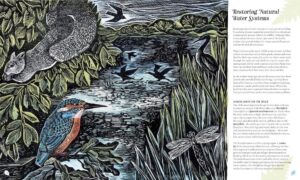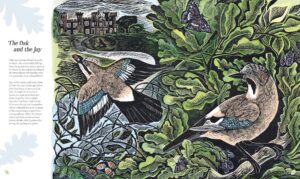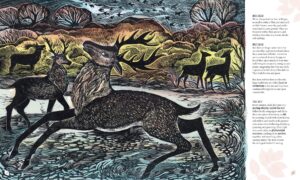Published next week by Macmillan, Isabella Tree’s bestselling book Wilding — a document of her and Charlie Burrell’s trail-blazing and influential rewilding experiment at their Knepp estate in Sussex — has been reimagined in a new edition, illustrated with beautiful lino prints and watercolours by Angela Harding.

In her artist’s note, Angela writes:
‘My first visit to the Knepp wilding project was in the early spring of 2022. The trees were still bare branches, the fields bleached by winter winds, and the roaming long-horned cattle still wearing their thick winter coats. But my first impression of Knepp was of a place packed with life. For 20 years, Charlie Burrell and Isabella Tree have been rewilding the land, letting nature take over, and the result is a very special place. Everywhere I looked I found something of beauty and interest that inspired my artwork.
I stayed in an extremely comfortable bothy set in the middle of a small wood. The bothy looked out over a pond that was fringed with rushes and water plants. It had many visitors, including red and fallow deer, wild Exmoor ponies and flocks of geese. I was able to draw and observe the wildlife without leaving my temporary home. But when I did venture out, there was even more to see; the scale of the Knepp project is quite breathtaking. The estate fields have been transformed from traditional English farmland to a jungle of thickets and scrub, and this new habitat now provides homes to a diverse range of birds, mammals and insects.
I visited Knepp 3 times over the same year, so I was able to see the seasons change. Each time I visited, I saw something new. The artwork I have created for this book is a direct response to being spellbound by this beautiful place. Many of the linocuts were made on site, drawing directly onto the lino and cutting it spontaneously as the images I saw were still fresh in my mind.
Knepp is a place of hope. It demonstrates the power of nature and that, with a little help, the natural world can gain a foothold once more. To hear nightingales singing against the background hum of the A24 is evidence of this. I have learned so much in the illustration work I have done for Wilding. But more than offering factual representations I hope my artwork conveys something of the emotions I feel about the countryside and a love of nature that we can all share.’

Isabella introduces the book:
‘When my husband Charlie and I began an experiment to rewild our 3,500 acres of land at Knepp in West Sussex in the southeast of England over 20 years ago we had no idea how exciting it would be. Knepp is now home to some of the rarest and most beautiful creatures in the UK, including nightingales, kingfishers, turtle doves and peregrine falcons, hazel dormice and harvest mice, scarce chaser dragonflies and purple emperor butterflies. The sheer abundance of life is staggering, too. When you walk out into the scrubland on an early spring morning the sound of birdsong is so loud it feels like it’s vibrating in your lungs.
Most astonishing of all is how fast our land has changed. Where once there were tightly clipped hedgerows, barbed wire fences, ditches, and ploughed fields devoid of life, we now have ponds and bogs, groves of trees and thickets of thorny shrubs, and patches of natural pasture. It’s easy to get lost. Winding through it all, are trails made by our herds of free-roaming animals. It looks wild and full of adventure, like the African bush.
Wildlife has been amazingly quick to find this rich new habitat. Virtually all the wonderful creatures that have made Knepp their home have found us on their own: a type of dung beetle, for example, that hasn’t been seen in Sussex for 50 years, and a butterfly – the large tortoiseshell – that was thought to be extinct in the UK. How they find us is a mystery but it’s one of the most hopeful messages of rewilding. Provide space for them, and they will come.
In a world where wildlife is rapidly disappearing, this is extremely heartening. Across the planet, a million species of plants and animals are in danger of extinction, threatened by human activities such as farming, heavy industry, roads and railways, and the building of towns and cities. When we think of damage to nature it’s easy to focus on the cutting down of trees in the Amazon rainforest, or wildfires in the Mediterranean, or areas of Africa that are turning into desert – the headlines that hit the news.
But we forget that wildlife is disappearing in our own backyard, too. The UK is one of the most nature-depleted countries in the world. There are 73 million fewer birds in our skies than there were in 1970. One quarter of native mammals in the UK are now at risk of extinction – including our much-loved hedgehogs and water voles. Most of our rivers are too polluted for us to swim in, let alone for water creatures to live in.
Rewilding shows us a way to reverse these declines. By restoring rivers, ponds and wetlands, allowing trees, shrubs and wildflowers to reseed themselves, and reintroducing large free-roaming animals to the land, we can bring back the conditions for life. And then, we can stand back and let the animals continue their work, driving the creation of new habitats and restoring the soil. This is what nature needs most: the time and the space to get on with it, doing what it does best – evolving to suit the circumstances.
But it’s not all about big landscapes. When an area of land is not big enough to contain free-roaming animals, humans can imitate them. We can act like beavers, creating new ponds and wet patches; we can clip back thorny scrub like the nibbling teeth of browsing ponies and deer; we can create wallows and scrapes like cattle and bison; and puddle the margins of ponds like the hooves of the water buffalo. Even in gardens, we can think like a beaver or a rootling wild boar. We can allow messy places with leaves and brambles for hedgehogs to live in, and provide plants with berries and seeds for birds, and pollen and nectar for bumblebees and hoverflies and night-flying moths.
Never has there been a more important time to engage in nature and its recovery, and I hope this book will be a source of hope and inspiration for a new generation. Nature can teach us what to do, and every one of us can make a difference. Together we can learn to be a keystone species, to bring wildlife back into our lives again, and help our planet to heal.’

*
Wilding: How to Bring Wildlife Back — An Illustrated Guide is published on 1st March. Pre-order a copy here (£19.00).
There are three events coming up with Isabella Tree and Angela Harding at which the author and illustrator will talk about creating the book and taking inspiration from the surroundings at Knepp. These are fabulous opportunities to see Angela’s work close up; she will bring her prints and lino events to each event.
Wed 6th March – Launch event at Knepp’s Wilding Kitchen & Shop to celebrate publication, with three course dinner and talk.
Thurs 7th March – Isabella and Angela will be in conversation at Brighton Girls School at 6pm for an event with City Books, Brighton.
Friday 19th April – Isabella and Angela will be talking at Waterstones Chichester.